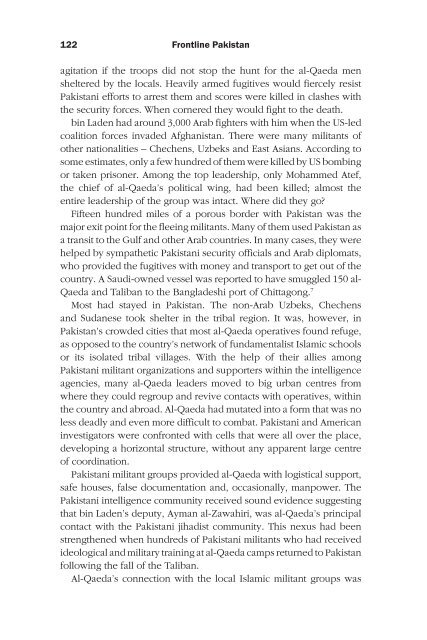Frontline Pakistan : The Struggle With Militant Islam - Arz-e-Pak
Frontline Pakistan : The Struggle With Militant Islam - Arz-e-Pak
Frontline Pakistan : The Struggle With Militant Islam - Arz-e-Pak
Create successful ePaper yourself
Turn your PDF publications into a flip-book with our unique Google optimized e-Paper software.
1 <strong>Frontline</strong> <strong><strong>Pak</strong>istan</strong><br />
agitation if the troops did not stop the hunt for the al-Qaeda men<br />
sheltered by the locals. Heavily armed fugitives would fiercely resist<br />
<strong><strong>Pak</strong>istan</strong>i efforts to arrest them and scores were killed in clashes with<br />
the security forces. When cornered they would fight to the death.<br />
bin Laden had around 3,000 Arab fighters with him when the US-led<br />
coalition forces invaded Afghanistan. <strong>The</strong>re were many militants of<br />
other nationalities – Chechens, Uzbeks and East Asians. According to<br />
some estimates, only a few hundred of them were killed by US bombing<br />
or taken prisoner. Among the top leadership, only Mohammed Atef,<br />
the chief of al-Qaeda’s political wing, had been killed; almost the<br />
entire leadership of the group was intact. Where did they go?<br />
Fifteen hundred miles of a porous border with <strong><strong>Pak</strong>istan</strong> was the<br />
major exit point for the fleeing militants. Many of them used <strong><strong>Pak</strong>istan</strong> as<br />
a transit to the Gulf and other Arab countries. In many cases, they were<br />
helped by sympathetic <strong><strong>Pak</strong>istan</strong>i security officials and Arab diplomats,<br />
who provided the fugitives with money and transport to get out of the<br />
country. A Saudi-owned vessel was reported to have smuggled 150 al-<br />
Qaeda and Taliban to the Bangladeshi port of Chittagong. 7<br />
Most had stayed in <strong><strong>Pak</strong>istan</strong>. <strong>The</strong> non-Arab Uzbeks, Chechens<br />
and Sudanese took shelter in the tribal region. It was, however, in<br />
<strong><strong>Pak</strong>istan</strong>’s crowded cities that most al-Qaeda operatives found refuge,<br />
as opposed to the country’s network of fundamentalist <strong>Islam</strong>ic schools<br />
or its isolated tribal villages. <strong>With</strong> the help of their allies among<br />
<strong><strong>Pak</strong>istan</strong>i militant organizations and supporters within the intelligence<br />
agencies, many al-Qaeda leaders moved to big urban centres from<br />
where they could regroup and revive contacts with operatives, within<br />
the country and abroad. Al-Qaeda had mutated into a form that was no<br />
less deadly and even more difficult to combat. <strong><strong>Pak</strong>istan</strong>i and American<br />
investigators were confronted with cells that were all over the place,<br />
developing a horizontal structure, without any apparent large centre<br />
of coordination.<br />
<strong><strong>Pak</strong>istan</strong>i militant groups provided al-Qaeda with logistical support,<br />
safe houses, false documentation and, occasionally, manpower. <strong>The</strong><br />
<strong><strong>Pak</strong>istan</strong>i intelligence community received sound evidence suggesting<br />
that bin Laden’s deputy, Ayman al-Zawahiri, was al-Qaeda’s principal<br />
contact with the <strong><strong>Pak</strong>istan</strong>i jihadist community. This nexus had been<br />
strengthened when hundreds of <strong><strong>Pak</strong>istan</strong>i militants who had received<br />
ideological and military training at al-Qaeda camps returned to <strong><strong>Pak</strong>istan</strong><br />
following the fall of the Taliban.<br />
Al-Qaeda’s connection with the local <strong>Islam</strong>ic militant groups was













